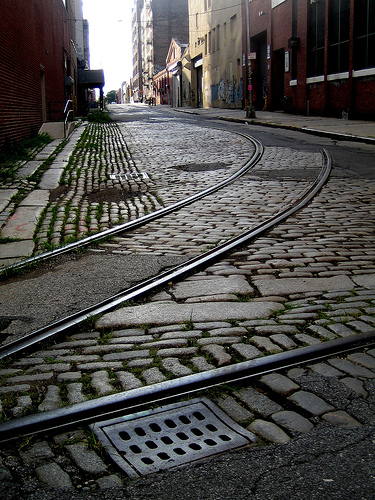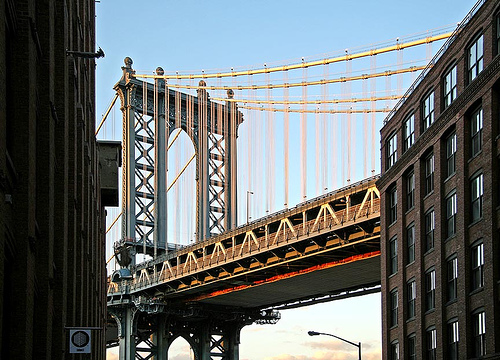Beauty Pageant

Photo: sps
The Landmarks Preservation Commission officially designated [pdf] the Dumbo historic today. Coming in the final LPC hearing of the year, this closes out what has turned out to be a banner year for the oft-maligned industrial heritage of the city. In addition to this designation, LPC has also designated the Domino Sugar Refinery, the Eberhard Faber Pencil Factory Historic District, the Standard Varnish Works Factory Building [pdf] (SI) and the Sohmer & Co. Piano Factory (Queens). Add to this the National Trust’s designation of the Brooklyn Waterfront as one of the nation’s 11 most endangered historic resources, and it was not a bad year at all for our industrial heritage.
Still, there are some enlightened souls who just don’t get it. For instance, this commenter on the Dumbo designation thread at Brownstoner:
when landmarking first started it was to save architecturally unique and interesting buildings and architecturally beautiful buildings. now it has become the protection of buildings just because they’re old. Dumbo has old buildings – buildings built in the late 1800s and early 1900s. can anyone point to any one building in Dumbo and explain what’s so unique or beautiful about them [sic] beyond [sic]? they’re nothing like the beautiful brownstones of Brooklyn Heights or Greenwich Village. they’re old factory buildings. they weren’t even built to be architecturally significant or interesting – just practical factories. all I have ever heard is that people in the neighborhood don’t want more J Condos. the prevention of new tall “ugly” buildings is not the same as protection of old buildings.
Well – there’s not a lot of love here for Dumbo, nor, by extension, anything that isn’t “beautiful” in the eye of the beholder. Lets take this one step at a time.
The commenter (lets call him “Guest 3:51”) starts out on pretty solid footing by saying that landmarking was intended to “save architecturally unique and interesting buildings”. Unfortunately he (for the sake of this discussion) ends the sentence with this fallacy: “and architecturally beautiful buildings”. There is nothing in the enabling legislation of the Landmarks Preservation Commission that talks about “beautiful buildings”. “Beauty”, “pretty”, “nice” – they are all words you do not find in Section 25-302: Definitions of the New York City Administrative Code. In fact, these words don’t appear anywhere in Chapter 3 (Landmarks Preservation and Historic Districts) of Title 25 (Land Use) of the Administrative Code.1
The Administrative Code is the only place where landmarks are legally defined. This is how a landmark is defined in Section 25-302 of Title 25:
Any improvement, any part of which is thirty years old or older, which has a special character or special historical or aesthetic interest or value as part of the development, heritage or cultural characteristics of the city, state or nation, and which has been designated as a landmark pursuant to the provisions of this chapter.
Pretty broad, no? Nowhere does the concept of beauty enter into equation. The closest one can get is the phrase “aesthetic interest”, but that’s not the same as “beautiful”.
So what did the Landmarks Commission find so compelling about Dumbo? Perhaps they found it beautiful (I do, but that’s besides the point), but that is not a reason (in the legal sense) to designate a historic district. Again, lets consult the law, which tells us that a historic district is:
any area which […] contains improvements which: (a) have a special character or special historical or aesthetic interest or value; and (b) represent one or more periods or styles of architecture typical of one or more eras in the history of the city; and (c) cause such area, by reason of such factors, to constitute a distinct section of the city…
Clearly, whether you find the neighborhood beautiful or not, Dumbo constitutes a distinct area of the city that has a special character, a special historical interest, and, I would argue, a special aesthetic interest or value. That, and the fact that it represents one or more periods or styles of architecture, clearly qualifies Dumbo to be a historic district.

Photo: DropFocus
Quite simply, it does not have to be beautiful. It has to be a lot of things to be a landmark district, but it does not have to be beautiful.
Guest 3:51 goes on to say “now it has become the protection of buildings just because they’re old. Dumbo has old buildings – buildings built in the late 1800s and early 1900s. can anyone point to any one building in Dumbo and explain what’s so unique or beautiful about them [sic] beyond [sic]?” No – its not “just because they are old”. It is because Dumbo has a special character and a special historical interest. Or, to use an overused phrase, because Dumbo has a sense of place. The Landmarks Commission has determined that that sense of place is significant, and that preserving that sense of place is in the larger interest of the City. Perhaps there are no individual buildings in the Dumbo historic that are so unique or beautiful that they should be individual landmarks, but that is not the point.2 The sum of the parts adds up to a distinct area of the city that has a special character and a special historic and aesthetic interest.
I’m sure there are those who would say of the recently designated Sunnyside Historic District “can anyone point to any one building in [Sunnyside] and explain what’s so unique or beautiful about them” (some of those people live there, in fact). And the question more validity when applied to Sunnyside – a planned development of architecturally homogenous buildings – than it does to Dumbo. But again, that is not the point. Sunnyside, like most of Dumbo (and like most of Soho, Noho and Tribeca) merits designation as a district because it has that elusive “sense of place” quality.
Guest 3:51 digs the hole deeper when he says: “[the buildings of Dumbo are] nothing like the beautiful brownstones of Brooklyn Heights or Greenwich Village”. Lets think about the hallowed brownstone for a second – sure it is a nice enough building type, but it is also pretty ubiquitous. The brownstone districts – and I would not call Brooklyn Heights or Greenwich Village brownstone districts3 – are significant, again, for their sense of place, not because any one building or collection of buildings is beautiful. Like Dumbo, they comprise distinct areas of the city that have a special character and a special historic or aesthetic interest. Certainly, the city has designated enough brownstones, and, if they were to be judged as individual buildings, would not need to designate any more. But individual beauty is not the criteria that is applied to Park Slope or the Upper West Side; nor should it be applied to Dumbo or Soho. All of these are neighborhoods that rise to the level of a special sense of place worthy of protection.
Then we get to the ugly utilitarian building canard: “they’re old factory buildings. they weren’t even built to be architecturally significant or interesting – just practical factories.” Well, no. Today we build functional factory buildings with little regard for aesthetics (not at all unlike the way we build our residential buildings). But in the late 19th and early 20th centuries that was absolutely not the case. Yes, many industrial buildings were utilitarian in nature. But they were still decorated boxes that usually reflected the prevailing architectural style. (Are brownstones really that different? Aren’t they simply facades (brick facades, at that) decorated with stone trim?) In Dumbo, we see a wonderful juxtaposition of the decorative and the utilitarian, played out in evolving architectural styles and building materials. Many of these buildings were designed to make a statement – they were advertisements for the companies that built them, and were used as such in letterheads and advertisements. Certainly they were built for utility – they had to function, first and foremost – but beyond that there was clearly and effort on the part of owner and designer to strive for the other two Vitruvean ideals: durability and beauty.

Photo: NewYorkDailyPhoto.com
Unlike brownstones, the reinforced concrete buildings of Dumbo represent an important advance in building technology, further emphasizing their historical significance. The material itself allowed more efficient and more open buildings in an era before efficient interior lighting. And the designers of the buildings clearly struggled to both find a new aesthetic for this new material (viz, the Austin, Nichols Warehouse) and to anchor the material in the past (Gair No. 6, or the former Dutch Mustard Company building, for instance). This is just one aspect of the special historic character of the district that LPC recognized today.
Landmarks has applied the same standards to individual landmark designations. Again, it is all subjective, but recall that Councilmember Simcha Felder called the Austin, Nichols Warehouse a “piece of trash“. Never mind that it was Louis Kestenbaum’s years of shoddy maintenance that most contributed to the worn appearance of the building.4 The fact is that that building, like so many other industrial buildings of that era, was designed (by one of the preëminent American architects) with a sense of monumentality, proportion and, yes, beauty in mind.
Guest 3:51 ends his post with another common refrain: “all I have ever heard is that people in the neighborhood don’t want more J Condos. the prevention of new tall “ugly” buildings is not the same as protection of old buildings.” Here, he has a point. Yes, landmarking is used to thwart development and stop ugly (and out of context buildings). Soho, when it was designated, was threatened with the Cross Manhattan Expressway. The role of the Landmarks Commission, though, is to apply the broad and subjective standards granted to it in the city charter, not as a tool for stopping development, but as a means of protecting that which has a “special character or special historical or aesthetic interest or value”. The sad fact is many city residents don’t think about their surroundings and what does (and does not) have that certain sense of place. Combine that with an understaffed Landmarks Commission that is rarely in a position to act proactively, and you have a process that is continually reacting to threats.
The bottom line, of course, is that beauty is in the eye of the beholder. Guest 3:51 is well within his rights to say that the buildings of Dumbo are not beautiful. But he misses the point entirely when he extrapolates his sense of the beautiful to the designation of a historic district. Because beauty is not in the Landmarks law. And it doesn’t belong there.
1 The Administrative Code can be found here. Its all encoded in Java, so I can’t link directly, but follow the directory path to Administrative Code Home->Title 25: Land Use->Chapter 3: Landmarks Preservation and Historic Districts.↩
2 Its also not true – off the top of my head, 1 Main Street, to name just one building, probably rises to the level of an individual landmark. I’m sure there are others.↩
3 Brooklyn Heights and Greenwich Village, the two earliest district designations, largely predate the brown decades of the post-Civil War era. What gives these neighborhoods their special character is their diversity of building styles and materials, and their unusual physical layout. They are, to my mind, the most wonderful districts in the city.↩
4 LPC Commissioner Gratz, in a different case, was right to note that the Commission should stand up and designate buildings that retain less than their full integrity. Particularly when that lack of integrity has come about as a result of prophylactic demolition – intentionally demolishing architecturally significant parts of a building in order to thwart a landmarks designation.↩

“special character or special historical or aesthetic interest or value” and “sense of place”, By your definition I’m not sure what neighborhood would not qualify for landmark designation if it was at least 30 years old. I live in Dumbo and work in Soho and Union Square and have seen first hand the smothering effect on small business that the LPC brings. It’s the equivalent of saying I love tigers and instead of contributing to their protection in the wild you go out and shoot and stuff one for your livingroom.
Things like Penn Station, Grand Central are easy calls but I’m not so sure about places like dumbo.
To paraphrase Oscar Wilde, “Be careful what you wish for, you just might get it.”
I suppose under a broad reading of the terms, yes, many neighborhoods over 30 years old could qualify for landmarks designation. In practice, I think LPC applies those standards pretty narrowly, and does look for significant and generally cohesive neighborhoods. The point is that it isn’t (and shouldn’t be) a Victorian-era beauty paegant.
I’m a Soho refugee myself, and have seen the transformation of that neighborhood over the past 20+ years first-hand. We left almost 15 years ago when it became too much of a destination (overrun every weekend), but still had no national chains. I don’t buy the idea that LPC smothers small businesses – they were, after all, designed to be commercial centers. However, areas like Soho and Union Square, if preserved, tend to become magnets for business. And its not long before the big chains take notice and try to cash in on the cachet that smaller businesses have created. (And they don’t like the LPC regulation, either.) By preserving a neighborhood, we do keep it eligible for gentrification, as it were. When it was designated, Soho was a rundown, gritty relic, with little aesthetic appeal beyond a small cohort of cast iron afficianados**. Had Soho not been regulated then, it would not be the mall that it is today. But it also wouldn’t be the amazing collection of early commercial buildings that is today. So I while I don’t think landmarking caused the “mallification” of Soho, it certainly enabled it.
It will be interesting to see how Dumbo develops. It is already in mid-transition demographically, but it does not have the same retail/commercial infrastructure that Soho and Union Square have. And, it does not have the central location that those neighborhoods have.
(** Ironically, the best place to see this today is at the Banana Republic at Broadway and Spring. They have a collection of photos of Soho in the 1970s or so. It was not a “beautiful” place. But it definitely had that “special historical and aesthetic interest”.)
A lot of my experience with LPC has been with street level businesses in buildings I manage in Soho and union square. Generally an awning that was installed before designation is allowed to stay, but no repairs or replacement in kind is allowed. I had a new tenant who painted out the old name and put his own on the awning. LPC gave a violation on the whole awning (it was not discreet, you might say it wasn’t beautiful either). The awning had to go. Once the awning was down there was an air conditioner that became visible. It protruded through the upper facade but did not break the property line. Since LPC had no photos that indicated the AC was there before designation it became a violation even though the opening had been there since before WW II. To make a long story short, Landlord pays architect for drawings, elevations material evals., presentations to LPC to fix facade 30 to 40 K. Charges tenant and tenant is soon to be evicted.
Halcyon (the record store) in Dumbo will be a good example also. They made a clever sign out of metal wall studs that was soon damaged after installation. That kind of sign would never be allowed in a landmark area to begin with but they installed several years ago. The problem now is if they try to repair it they will get a violation likewise if they try to replace with the same it will be a violation.
LPC puts a damper on any interesting new business that might want to start up. All of the glass fronts on the likes of ReBar, Superfine, Foragers would not past LPC protocol.
True – though the same standards do apply to large and small retailers. In Soho, the large retailers go nuts because the store next door has a grandfathered banner sign and Mr Megaretailer is limited to a 18×24 blade sign. Of course Mr Mega is in a better financial situation to deal with violations and hire architects and the like.
As for the Dumbo stores, LPC will (or probably has) taken photos of all of the buildings “at the time of designation”, and all of the example you cite should be grandfathered. New retailers will have to design “appropriate” storefronts and signs – again, not necessarily an inexpensive proposition.